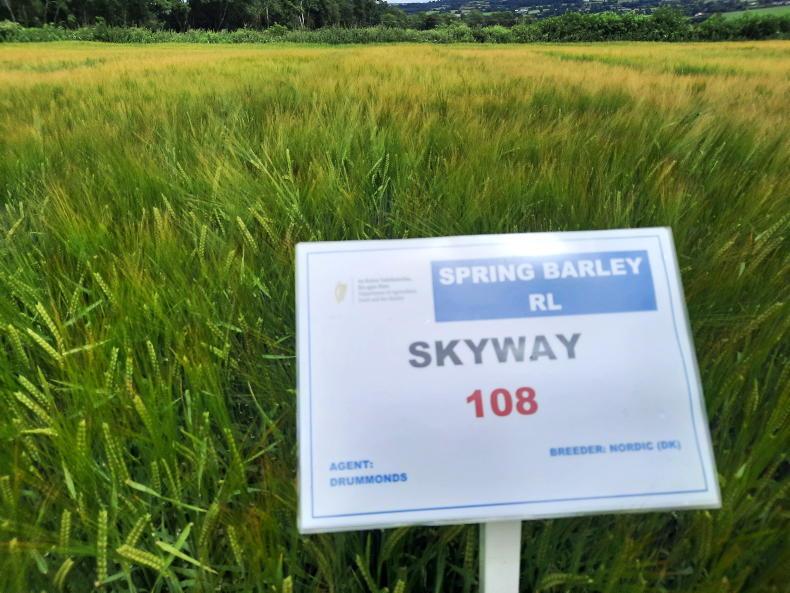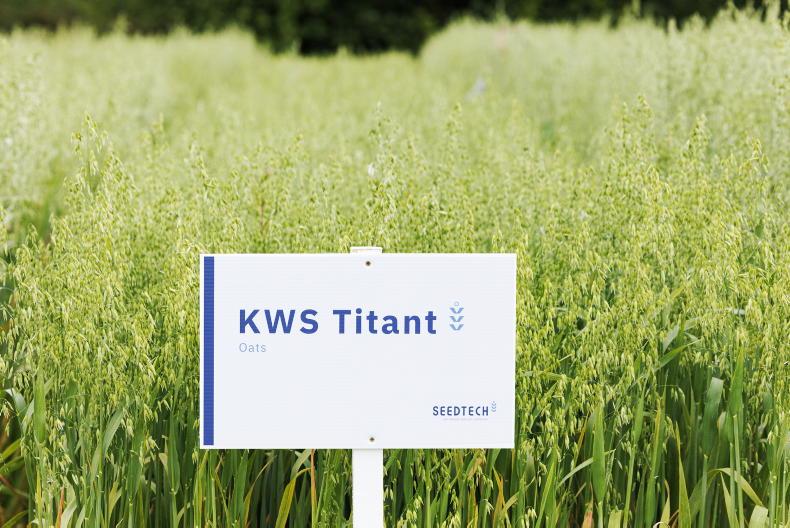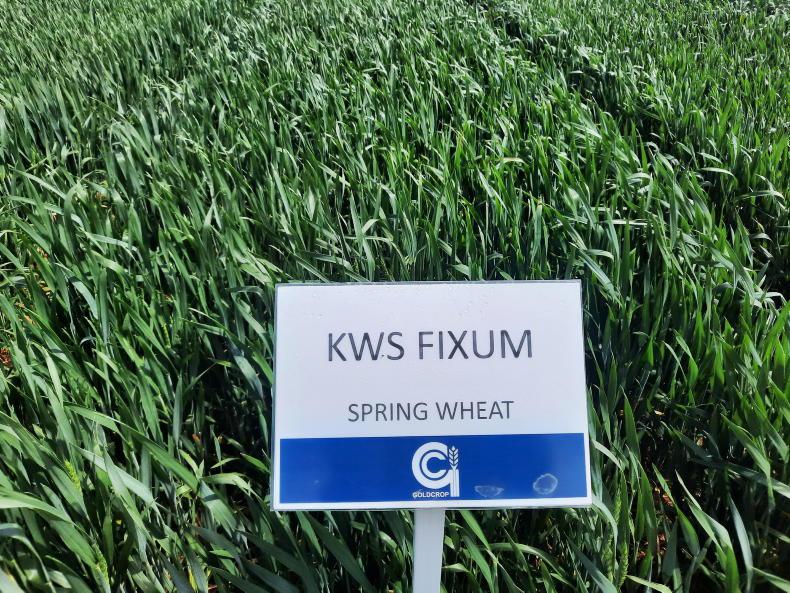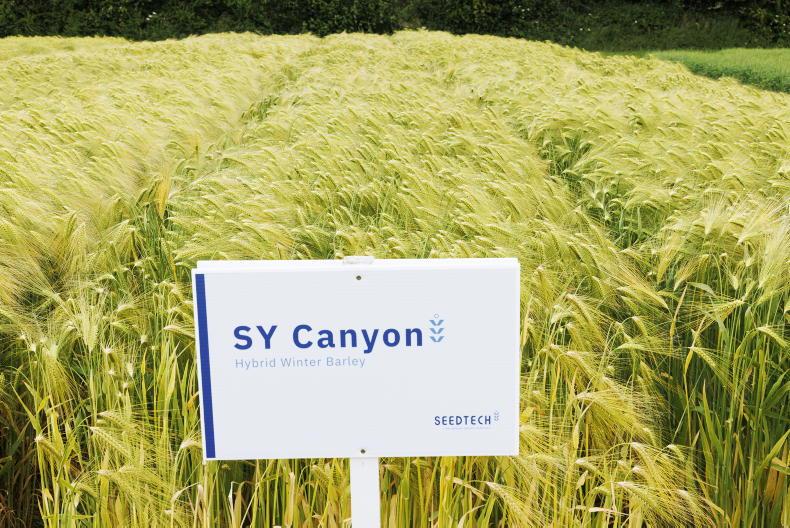Each year, the Department of Agriculture releases recommended lists for cereals, beans and oilseed rape. These lists are very important when deciding on which variety to grow. They provide information on grain yields, grain quality, straw strength, crop maturity and disease resistance.
Different farmers will look for different things in a variety. For example, growers with a lot of one crop will need different maturity dates in varieties and strong resistance levels to straw breakdown. In the northeast, on winter wheat, good resistance to yellow rust will be very important, while growers in the south of the country will be looking out for good resistance to septoria.
If you know the different traits of varieties you can manage that variety accordingly.
For example, if you know it is prone to yellow rust then you can apply a T0 to that crop of winter wheat. The recommended lists also allow farmers to cut back on some inputs and concentrate some inputs on issues that a particular variety has.
Using strong varieties and managing varieties to their strengths and weaknesses is a part of integrated pest management (IPM) which we now hear so much about as the EU has set targets to reduce pesticide use.
The recommended lists are shown across these pages for winter and spring wheat, barley and oats, winter oilseed rape and spring beans. We have also outlined some things to look out for in each crop.
Winter wheat
Keep an eye on growth regulation on Spearhead and Champion which have poor resistance to lodging. Nitrogen rates might need a closer eye on these varieties.
Graham has poor resistance to straw breakdown as well so needs a robust growth regulation and disease programme.
Torp is the only one to look out for on mildew. Fitzroy is the only variety with a resistance score of seven to septoria. All varieties need strong septoria disease control programmes. KWS Dawsum and Fitzroy have good yellow rust resistance. Other varieties need good yellow rust control and most likely a T0.
Winter barley

Orcade winter barley. \ Donal O'Leary
The first thing to note on winter barley are the varieties with Barley Yellow Dwarf Virus tolerance – KWS Joyau, Molly and Orcade. These varieties will not need an aphicide as urgently as others in a wet autumn.
KWS Cassia, Molly and SY Canyon have poor resistance to straw breakdown so will need good plant growth regulation, disease control and nutrition.
There are some winter barley varieties with poor resistance to mildew, but the SDHI fungicides should keep this at bay. KWS Cassia is low on resistance to rhynchosporium so needs a strong disease control programme. KWS Joyau and Integral are ones to watch out for, for rhynchosporium as well. SY Canyon has a lower resistance to net blotch than other varieties so will benefit from a strobilurin fungicide.
Winter oats
Keep an eye on WPB Enya for lodging. Watch nitrogen rates. Husky is behind on resistance to straw breakdown. All varieties are similar on disease, but Husky is more prone to Crown Rust.
Winter oilseed rape

Aurelia hybrid winter oilseed rape. / Patrick Browne
Winter oilseed rape varieties are now very robust due to improved genetics. Light leaf spot is a disease to look out for in all crops, but Ambassador has the lowest resistance score for the disease.
Spring barley

Skyway spring barley.
LG Mermaid, RGT Planet and Skyway are all weaker on resistance to lodging and straw breakdown compared to other varieties so watch nitrogen rates and growth regulation, as well as nutrition on these varieties. Lollipop is also weaker on resistance to lodging.
Watch out for rhynchosporium in Gangway, RGT Planet and SY Amity. RGT Planet is also weak on resistance to net blotch so will benefit from a strobilurin at the T1 fungicide. Keep an eye out for Brown Rust in Florence and RGT Planet.
Spring oats

KWS Titant spring oats. \ Donal O'Leary
KWS Titant is weak on resistance to lodging and straw breakdown. Straw breakdown can also be an issue in Husky. KWS Titant is strong on resistance to mildew, but all other varieties need to be watched for diseases. Husky is particularly weak on Crown Rust.
Spring wheat

KWS Fixum spring wheat.
KWS Helium and WPB Duncan both fall down on resistance to lodging, but KWS Fixum needs attention on straw as well. KWS Fixum and Helium are weak on resistance to septoria with a score of five. Both are weak on yellow rust as well.
Spring beans

Lynx beans.
Victus are weakest on brackling resistance so proper nutrition will be important here. Lynx and Victus have the lowest resistance to rust. Protina has very good resistance to Downy Mildew.
Each year, the Department of Agriculture releases recommended lists for cereals, beans and oilseed rape. These lists are very important when deciding on which variety to grow. They provide information on grain yields, grain quality, straw strength, crop maturity and disease resistance.
Different farmers will look for different things in a variety. For example, growers with a lot of one crop will need different maturity dates in varieties and strong resistance levels to straw breakdown. In the northeast, on winter wheat, good resistance to yellow rust will be very important, while growers in the south of the country will be looking out for good resistance to septoria.
If you know the different traits of varieties you can manage that variety accordingly.
For example, if you know it is prone to yellow rust then you can apply a T0 to that crop of winter wheat. The recommended lists also allow farmers to cut back on some inputs and concentrate some inputs on issues that a particular variety has.
Using strong varieties and managing varieties to their strengths and weaknesses is a part of integrated pest management (IPM) which we now hear so much about as the EU has set targets to reduce pesticide use.
The recommended lists are shown across these pages for winter and spring wheat, barley and oats, winter oilseed rape and spring beans. We have also outlined some things to look out for in each crop.
Winter wheat
Keep an eye on growth regulation on Spearhead and Champion which have poor resistance to lodging. Nitrogen rates might need a closer eye on these varieties.
Graham has poor resistance to straw breakdown as well so needs a robust growth regulation and disease programme.
Torp is the only one to look out for on mildew. Fitzroy is the only variety with a resistance score of seven to septoria. All varieties need strong septoria disease control programmes. KWS Dawsum and Fitzroy have good yellow rust resistance. Other varieties need good yellow rust control and most likely a T0.
Winter barley

Orcade winter barley. \ Donal O'Leary
The first thing to note on winter barley are the varieties with Barley Yellow Dwarf Virus tolerance – KWS Joyau, Molly and Orcade. These varieties will not need an aphicide as urgently as others in a wet autumn.
KWS Cassia, Molly and SY Canyon have poor resistance to straw breakdown so will need good plant growth regulation, disease control and nutrition.
There are some winter barley varieties with poor resistance to mildew, but the SDHI fungicides should keep this at bay. KWS Cassia is low on resistance to rhynchosporium so needs a strong disease control programme. KWS Joyau and Integral are ones to watch out for, for rhynchosporium as well. SY Canyon has a lower resistance to net blotch than other varieties so will benefit from a strobilurin fungicide.
Winter oats
Keep an eye on WPB Enya for lodging. Watch nitrogen rates. Husky is behind on resistance to straw breakdown. All varieties are similar on disease, but Husky is more prone to Crown Rust.
Winter oilseed rape

Aurelia hybrid winter oilseed rape. / Patrick Browne
Winter oilseed rape varieties are now very robust due to improved genetics. Light leaf spot is a disease to look out for in all crops, but Ambassador has the lowest resistance score for the disease.
Spring barley

Skyway spring barley.
LG Mermaid, RGT Planet and Skyway are all weaker on resistance to lodging and straw breakdown compared to other varieties so watch nitrogen rates and growth regulation, as well as nutrition on these varieties. Lollipop is also weaker on resistance to lodging.
Watch out for rhynchosporium in Gangway, RGT Planet and SY Amity. RGT Planet is also weak on resistance to net blotch so will benefit from a strobilurin at the T1 fungicide. Keep an eye out for Brown Rust in Florence and RGT Planet.
Spring oats

KWS Titant spring oats. \ Donal O'Leary
KWS Titant is weak on resistance to lodging and straw breakdown. Straw breakdown can also be an issue in Husky. KWS Titant is strong on resistance to mildew, but all other varieties need to be watched for diseases. Husky is particularly weak on Crown Rust.
Spring wheat

KWS Fixum spring wheat.
KWS Helium and WPB Duncan both fall down on resistance to lodging, but KWS Fixum needs attention on straw as well. KWS Fixum and Helium are weak on resistance to septoria with a score of five. Both are weak on yellow rust as well.
Spring beans

Lynx beans.
Victus are weakest on brackling resistance so proper nutrition will be important here. Lynx and Victus have the lowest resistance to rust. Protina has very good resistance to Downy Mildew.
















SHARING OPTIONS